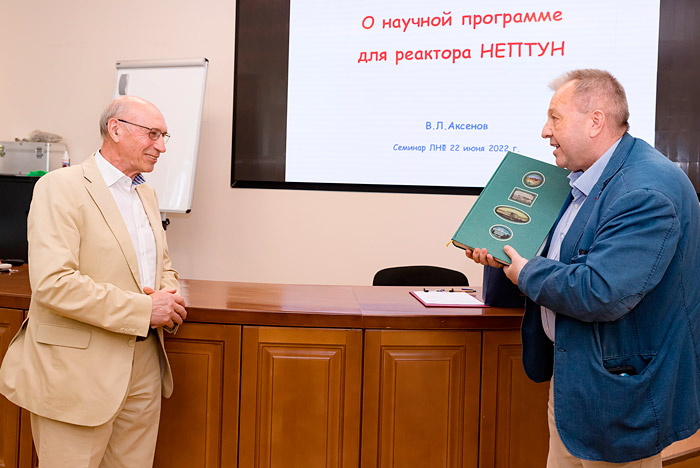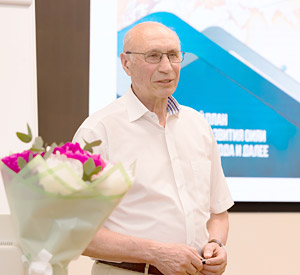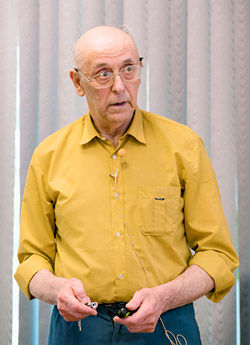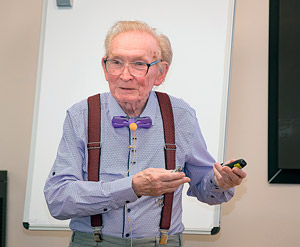
Electronic english version since 2022 |
The newspaper was founded in November 1957
| |
Seminars
Remembering the history, thinking about the future
On 22 June, in the crowded Сonference hall of the Frank Laboratory of Neutron Physics, in a warm and friendly atmosphere, a laboratory seminar dedicated to the 75th anniversary of V.L.Aksenov was held. The reports were made by the hero of the day himself, Yu.N.Pokotilovsky and E.P.Shabalin. Congratulations had been also heard at the seminar the day before, when A.F.Gubkin, President of the Russian Neutron Diffraction Society (RNDS) from the Institute of Reactor Materials of Rosatom (Zarechny), spoke at the Laboratory. He recalled that V.L.Aksenov had stood at the origins of the RNDS and had been its first President.
Opening the seminar, FLNP Director V.N.Shvetsov called it historical, as it is dedicated to the future history - "the history of pulsed reactors, projected 20 years ahead. And the person to whom this seminar is dedicated is widely involved in this activity." On behalf of JINR Directorate, Vice-Director L.Kostov congratulated V.L.Aksenov. The labor activity of the hero of the day at the Joint Institute began in 1973 and all these years it has been and remains wide and very successful. His contribution to the development of the Laboratory and international relations of the Institute is well known to the staff of the Laboratory. "He is a talented person. I met him 25 years ago when I visited FLNP for the first time as Plenipotentiary Representative of the Government of Bulgaria to JINR. The clarity of his thinking, his charm left an indelible impression and he has remained as such for me to this day."

V.N.Shvetsov continued the seminar, "It seems to me an exceptional luck that Viktor Lazarevich headed the Laboratory in a difficult time in the early 1990s. He organised the training of specialists for FLNP, a significant part of the employees of the Department of Condensed Matter Physics are graduates of his departments at MEPhI and MSU. With his direct participation, a high-temperature superconductivity research program was organized that gave impetus to the development of the IBR-2 reactor. Reactor modernisation is the most complicated and lengthy procedure that began in the 1990s and required tremendous work with Rosatom organisations. Most importantly, the issue of manufacturing fuel elements for the reactor core at Rosatom enterprises was resolved."
 "The IBR-2 reactor is really outstanding, it's not for our audience to talk about it," V.L.Aksenov began his report "On the scientific program for the NEPTUNE reactor" (the second title: "Do pulsed reactors have a future?"), yet it has two limitations when using. First, the average neutron flux density is not high enough for fundamental and nuclear physics that is determined by the average power. Secondly, after achieving a certain fuel burnup, oscillatory instabilities of power pulses occur. In the case of the modernised IBR-2, this does not pose a danger, the nuclear safety sector and the reactor personnel successfully meet it, but over time, the power has to be reduced and, accordingly, the possibilities for research are also reduced. E.P.Shabalin proposed a design for the NEPTUNE reactor that would eliminate both limitations: increase the neutron flux by more than an order of magnitude, increasing the average power and suppress oscillatory instabilities. Moreover, this is possible only with the use of new fuel based on the neptunium-237 isotope. Only in this case pulsed reactors will have development prospects; based on plutonium, they have reached their limit. It's a matter of prestige. Pulse reactors were born and developed here, in Dubna, this is our heritage. Today we have the opportunity to reach a fundamentally new level of research using neutrons.
"The IBR-2 reactor is really outstanding, it's not for our audience to talk about it," V.L.Aksenov began his report "On the scientific program for the NEPTUNE reactor" (the second title: "Do pulsed reactors have a future?"), yet it has two limitations when using. First, the average neutron flux density is not high enough for fundamental and nuclear physics that is determined by the average power. Secondly, after achieving a certain fuel burnup, oscillatory instabilities of power pulses occur. In the case of the modernised IBR-2, this does not pose a danger, the nuclear safety sector and the reactor personnel successfully meet it, but over time, the power has to be reduced and, accordingly, the possibilities for research are also reduced. E.P.Shabalin proposed a design for the NEPTUNE reactor that would eliminate both limitations: increase the neutron flux by more than an order of magnitude, increasing the average power and suppress oscillatory instabilities. Moreover, this is possible only with the use of new fuel based on the neptunium-237 isotope. Only in this case pulsed reactors will have development prospects; based on plutonium, they have reached their limit. It's a matter of prestige. Pulse reactors were born and developed here, in Dubna, this is our heritage. Today we have the opportunity to reach a fundamentally new level of research using neutrons.
The NEPTUNE project aroused great interest in Rosatom, since there have been no new reactor projects in the country for 30-40 years and neptunium as a material for nuclear devices has been discussed for a long time and there is a good reason to start working with new material in the civil sphere. By supporting the project at the December 2019 meeting of the Presidium of the Science and Technology Council of Rosatom jointly with JINR Directorate and including it in the strategic plan for the development of JINR until 2030 and beyond, the preparatory stage was completed. Today, to implement the project of a new reactor, to obtain financial support, a weighty scientific justification is needed."
"The general outlines of the scientific program for the NEPTUNE reactor were presented in my report at the meeting of the PAC for CMP in January 2017," V.L.Aksenov continued. "Unfortunately, until today we have not made any significant progress in writing the Conceptual Design Report, from which the walk around the offices begins. It is also important that the scientific program and the concept of the corresponding complex of spectrometers that constitute an essential part of the CDR, must be taken into account when designing a reactor facility. Actually, this seminar is due to these circumstances in order to once again draw attention to the main points of the document we need.
The first thing the speaker drew attention to was fundamental and nuclear physics that is in much poorer state in FLNP today than the condensed matter physics. To substantiate the scientific program, weighty and large projects of experimental complexes are needed, such as those being developed at the PIK reactor at the PNPI NRC KI (Gatchina) and at ESS in Sweden. For example, ultracold neutrons (UCNs) were discovered in Dubna, but FLNP physicists carry out experiments with them all over the world, except for Dubna. There are interesting preliminary studies in the development of efficiently reflecting surfaces (E.V.Lychagin and et al.) and in the temporal focusing of a neutron beam (A.I.Frank and co-workers). All this can serve as a basis for the proposal of a large-scale project of the Factory of very cold and ultracold neutrons."
"Besides, I constantly promote the development of the Factory of neutron-excess nuclides for nuclear physics and astrophysics at the NEPTUNE reactor," the speaker noted. "This overlaps with FLNR research, but the scientific program of FLNP should be part of the general Institute scientific program. This was also the case with the high-temperature superconductivity program, in which all JINR Laboratories were involved. And now neutrons will be able to make a significant contribution to this pattern."
"In the research of the soft matter the strategy is simple," V.L.Aksenov emphasized, "to prepare the infrastructure for new challenges, since in this area, limitless in terms of potentially new phenomena, it is simply impossible to predict epoch-making discoveries. One can only guess the trends. That is how, at the suggestion of colleagues from Gatchina, we constructed a high-resolution Fourier diffractometer and it brought structural studies at IBR-2 to the highest advanced level. As part of this strategy, one must follow this tactic: do what is not available to others. FLNP has a number of pioneering projects that have been started and not yet fully implemented. For example, diffraction in real time or in strong pulsed fields, reflectometry with Larmor precession, as well as with very cold neutrons and more. All this will be possible at the NEPTUNE reactor.
Particular emphasis in the scientific program should be on the requests of Rosatom, on which the fate of the new reactor ultimately depends. We also have experience in this area and these requests fit well into our interests.
There is absolutely no discussion and involvement in the compilation of the scientific program of Member States, although users have always been our trump card.
And with IBR-2, we need to reorganize psychologically. Until now, we have been mercilessly exploiting this machine but it must be protected, then perhaps we will live to see a new reactor. IBR-2 should also be used for reactor testing to assess the theory of the NEPTUNE reactor."
Concluding his report, Viktor Lazarevich noted, "I am sure that pulsed reactors have a future and a new reactor will be developed. I hope that this will take place in Dubna since our wonderful team and JINR as a whole will be able to realize it."
 Yu.N.Pokotilovsky began his report "On Fundamental Research at the NEPTUNE Reactor" with the remark that it is impossible to predict what fundamental research will be carried out at the future reactor. "I will review what's on the agenda today, which experiments with neutrons contribute to fundamental interactions." He named the first study of the neutron-antineutron oscillation. The second is an ongoing experiment to search for the electric dipole moment of the neutron. These investigations began a very long time ago. Currently, they are carried out in Gatchina and in several laboratories in Germany, France, Switzerland, the USA, Canada and Japan. In order to be involved in this experiment at the NEPTUNE reactor, a UCN source is needed. It is difficult to imagine how UCN physics will develop in Russia, the speaker noted, let's hope that a UCN source will be built at the NEPTUNE reactor. The third is the measurement of the neutron lifetime. Our Laboratory has made a significant contribution to this work, but more powerful UCN sources are required. The fourth is an experiment to determine angular correlations in neutron decay. Such research will be implemented for an indefinite time, since this is a very important baryon experiment.
Yu.N.Pokotilovsky began his report "On Fundamental Research at the NEPTUNE Reactor" with the remark that it is impossible to predict what fundamental research will be carried out at the future reactor. "I will review what's on the agenda today, which experiments with neutrons contribute to fundamental interactions." He named the first study of the neutron-antineutron oscillation. The second is an ongoing experiment to search for the electric dipole moment of the neutron. These investigations began a very long time ago. Currently, they are carried out in Gatchina and in several laboratories in Germany, France, Switzerland, the USA, Canada and Japan. In order to be involved in this experiment at the NEPTUNE reactor, a UCN source is needed. It is difficult to imagine how UCN physics will develop in Russia, the speaker noted, let's hope that a UCN source will be built at the NEPTUNE reactor. The third is the measurement of the neutron lifetime. Our Laboratory has made a significant contribution to this work, but more powerful UCN sources are required. The fourth is an experiment to determine angular correlations in neutron decay. Such research will be implemented for an indefinite time, since this is a very important baryon experiment.
And then there is a long list of non-standard experiments, for example, to determine the manifestations of dark energy and dark matter in a neutron experiment. Many of them can be carried out at the NEPTUNE reactor, it is necessary to establish an appropriate experimental school.
 The report of E.P.Shabalin "On the dynamics of pulsating reactors" had the second title "Dialectics of learning the truth from one's mistakes (1956-2022)". Indeed, FLNP staff had no one else's experience in developing pulsed reactors (PR), so they learned from their mistakes. Evgeny Pavlovich remembered the authors of the first theory of PR - I.I.Bondarenko and Yu.Ya.Stavissky, as well as the main people for the development of these reactors - D.I.Blokhintsev and F.L.Shapiro. "Mistakes always provoke truth, analysis of mistakes is the way to discoveries," the speaker declared and as proof of this statement, he gave a list of mistakes that had been at the first IBR reactor and the results of their elimination.
The report of E.P.Shabalin "On the dynamics of pulsating reactors" had the second title "Dialectics of learning the truth from one's mistakes (1956-2022)". Indeed, FLNP staff had no one else's experience in developing pulsed reactors (PR), so they learned from their mistakes. Evgeny Pavlovich remembered the authors of the first theory of PR - I.I.Bondarenko and Yu.Ya.Stavissky, as well as the main people for the development of these reactors - D.I.Blokhintsev and F.L.Shapiro. "Mistakes always provoke truth, analysis of mistakes is the way to discoveries," the speaker declared and as proof of this statement, he gave a list of mistakes that had been at the first IBR reactor and the results of their elimination.
"Recently, the greatest attention has been drawn to the issue of oscillatory instability of power pulses that makes it necessary to reduce the power of the reactor during operation," E.P.Shabalin said. "In the IBR-2 reactor, this situation began about 15 years after the physical launch and in the modernized IBR-2 - already after 7 years. In the dynamics of PR, the properties of discrete systems are manifested due to periodic short power pulses. In the equilibrium (steady) operation mode of the PR, the occurrence of oscillatory processes with a period that is a multiple of the period of pulsations is its characteristic property. The mode of self-oscillations can be both quasi-periodic and unsteady. In this case, one speaks of impulsive instability, in contrast to asymptotic instability, when the increase in the amplitude of power pulses is monotonic. This behavior of PR can be explained by the phenomenon of dynamic bending of fuel elements that was discovered during the development of the conceptual design of the NEPTUNE reactor. We believe that this phenomenon underlies the oscillatory instability of the PR and taking it into account when designing the NEPTUNE reactor core will help to solve the main task of the PR that leads to power limitation.
After the accident at IBR-30 in 1972, N.N.Bogolyubov was opposed to reactors, but I.M.Frank managed to prove to him that there had been no accident. Thus, he saved the reactor and FLNP. Later, Nikolay Nikolayevich sent one of his students to the Laboratory. Viktor Lazarevich appeared at FLNP at a very important moment, when the IBR-2 reactor was in the process of development. Later, in the difficult 1990s, he managed to organize a decent salary for the shift staff of IBR-2, when the situation was teetering on the brink of a strike. The speaker noted the role of the celebrant in the modernisation of IBR-2, his huge contribution to the development of the PIK reactor in Gatchina. This reactor was conceived back in the 1960s but it was built very slowly. In the 1990s, everything stopped, and only in 2010, after the PNPI joined the NRC KI, did real movement begin. After the appointment of V.L.Aksenov as Director of the PNPI NRC KI, the construction of the reactor complex was completed in four years.
Evgeny Pavlovich's report was accompanied by historical photographs from the life of FLNP and the hero of the day. And the final slide of the report was: "The end? There is still more to be done..."
Olga Tarantina,
photo by Elena Puzynina